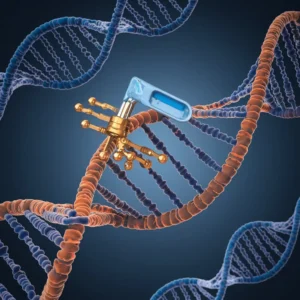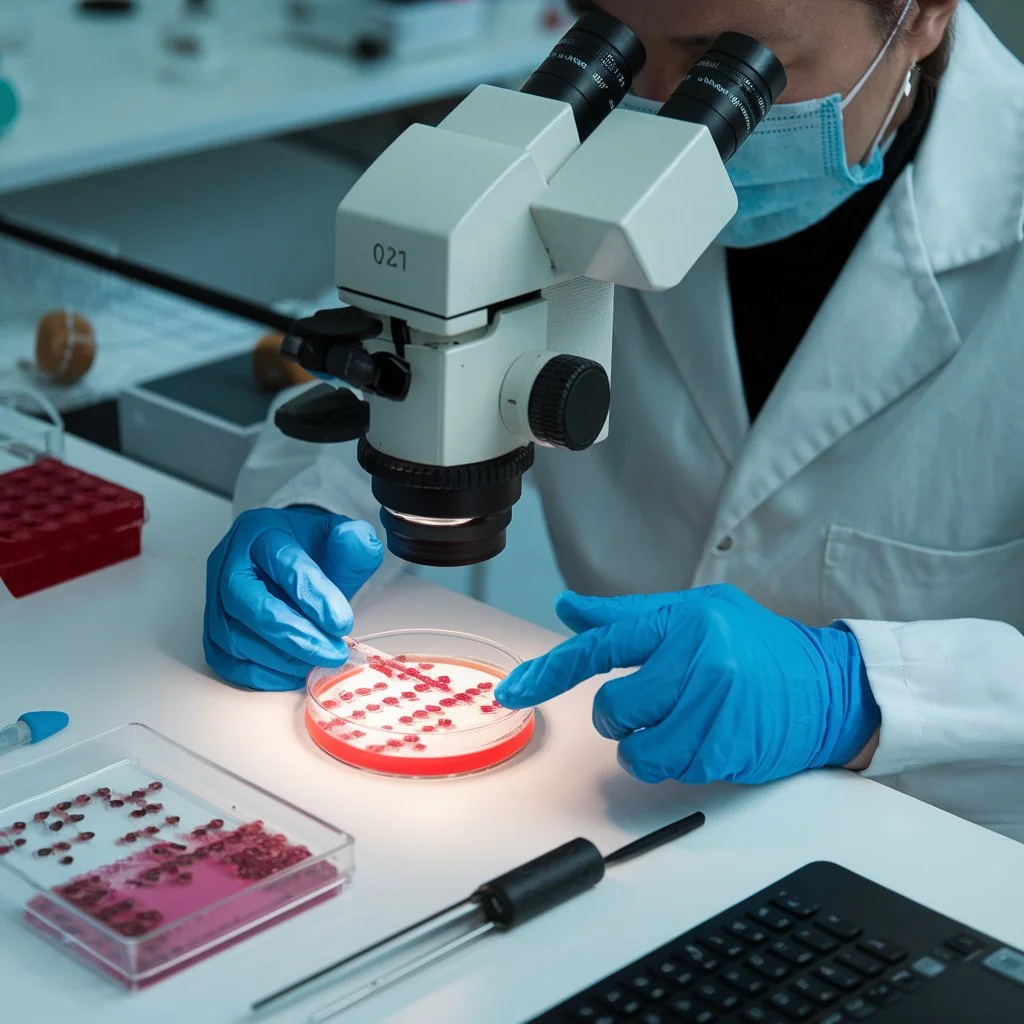In an era where scientific discoveries are being made at an unprecedented rate, one ground-breaking technology—CRISPR—stands out as a ray of hope and inventiveness. Imagine being able to alter genes like lines in a text page, improving crops for greater yield, fixing mistakes that cause diseases, or even developing ground-breaking therapies for hereditary illnesses. This is actuality; it is not science fiction! Come along for a thrilling adventure as we explore the fascinating realm of CRISPR technology. We’ll examine its amazing potential, unearth the science behind it, and talk about the moral conundrums that arise from having such great control over nature. Prepare to discover life’s mysteries, one gene at a time!
Overview of CRISPR Technology
Envision a future in which genetic diseases are eliminated, crops may flourish in arid environments, and threatened animals can be brought back to life. This is the fascinating field of current biology known as CRISPR technology, not science fiction. The CRISPR revolution has revolutionized our knowledge of genetics and created previously unimaginable opportunities. This innovative instrument, which can alter DNA with astonishing accuracy, gives humanity new hope, but it also raises important ethical considerations about the limits of our power to manipulate life itself. Come along on an exploration of the mysteries surrounding CRISPR technology and its profound effects on our planet.
The Origins and Exploration
The late 20th century saw the beginning of the CRISPR tale. Scientists discovered an odd pattern in the DNA sequences of bacteria. These segments were unique and are now referred to as Clustered Regularly Interspaced Short Palindromic Repeats, or CRISPR.
Scientists discovered their actual function in 2007: defence against viral invaders. By slicing viral DNA, bacteria employ CRISPR to recall previous infections and fend against new dangers. This discovery made genetic study possible.
In the year 2012, Emmanuelle Charpentier and Jennifer Doudna utilized this technique to modify genes. Their ground-breaking research made CRISPR a cutting-edge technology with countless applications in genetics.
What began as a survival strategy for microbes has developed into one of science’s most significant discoveries, setting the stage for the phenomenon that many now refer to as the “CRISPR Revolution.”
How Is CRISPR Operated?
CRISPR technology functions similarly to a pair of molecular shears for DNA. It is essentially made up of two essential parts: the Cas9 protein and the guide RNA. The target DNA’s exact sequence is what the guide RNA is made to match.
This RNA directs Cas9 to the precise spot that has to be edited when it is inserted into cells. Once there, Cas9 attaches itself to the DNA and carefully cuts it there. The inherent repair processes of the cell are activated by this activity.
During the repair process, cells can then either insert new genetic material or remove undesirable sequences. With amazing accuracy, scientists may now make targeted alterations because to this ability.
When compared to other gene-editing technologies, CRISPR’s simplicity and efficiency are what make it so beautiful. Through the use of these resources, scientists are delving into hitherto unexplored areas of genetics and biotechnology.
Utilizing for Editing Genes
Gene editing is being revolutionized in many different sectors by CRISPR technology. It has the potential to treat genetic illnesses including sickle cell anemia and cystic fibrosis in medicine. Through targeted gene targeting, scientists hope to stop mutations before they start.
CRISPR makes it possible to build crops in agriculture that are more resistant to illnesses and climate change. By using fewer resources to achieve higher yields, farmers can ultimately contribute to food security.
Applications in the environment are also important. In order to prevent invasive species or increase biodiversity, researchers employ CRISPR in conservation efforts. In today’s world of fast change, the ability to restore ecosystems is both fascinating and vital.
Experts are constantly being surprised by how versatile CRISPR is, as new applications keep popping up. Because of its versatility, it can be used to address some of the most important problems facing humanity and pave the way for creative solutions that were previously unthinkable.
Health and Medical Advantages
Medicine is undergoing a significant shift thanks to CRISPR technology. Its capacity to precisely alter DNA makes it possible to treat hereditary illnesses that were previously thought to be incurable. Targeted medicines have made conditions like sickle cell anemia and cystic fibrosis attainable.
Researchers are also looking into how CRISPR might be used to treat cancer. Researchers hope to develop tailored treatments that strengthen the body’s defences against tumours by altering immune cells. This strategy might result in less harmful treatments that are also more successful.
Furthermore, CRISPR may be useful in the fight against infectious illnesses like hepatitis B and HIV. Viral genomes can be disrupted via gene editing, which may completely eradicate infections from patients’ bodies.
There are significant ramifications for public health. Thanks to CRISPR, there might be a time in the future when hereditary illnesses become less common, enabling people to lead healthier lives without of genetic constraints.
Progress in Agriculture and Environment

The use of CRISPR technology in agriculture is revolutionizing crop cultivation. Imagine having plants that can withstand pests and drought without requiring toxic pesticides. This invention protects the environment and enables farmers to produce better yields.
Furthermore, scientists can improve the nutritional value of staple foods thanks to CRISPR. They can prevent malnutrition where it is most required by boosting vitamins and minerals by focusing on particular genes.
This gene-editing technology has additional benefits for environmental sustainability. Researchers are using CRISPR to create crops that need less fertilizer and water. As populations increase, these developments contribute to less resource usage while maintaining food security.
Furthermore, by creating plants that can flourish on degraded soils or adapt to changing temperatures, CRISPR holds promise for repairing ecosystems. With their promise of productivity and environmental balance, these innovative techniques could be the deciding factor in the future of agriculture.
Ethical Questions and Debates
The development of CRISPR technology has led to heated ethical discussions. The question of what should be changed and by whom arises when we have the ability to edit genes.
A significant worry is the possibility of designer offspring. The attraction of improved features gives rise to concerns of social pressure and inequity. Will we see a gap emerge between people with “improved” DNA and those without if only a select few can afford genetic modifications?
Concerns about biodiversity in agriculture are also present. Gene editing may result in monocultures or inadvertently damage ecosystems, even though it can generate robust crops.
Furthermore, there are a lot of ethical conundrums raised by the idea of modifying human embryos. Many contend that this might impede natural evolution or have unanticipated effects.
These debates make us think about our roles as producers in a society where ethics and science conflict. Every discovery must be carefully considered in light of its potential effects on future generations of humans and the planet.
Future Consequences and Opportunities
CRISPR technology has a bright future ahead of it. Envision eliminating inherited illnesses that have afflicted families for numerous generations. Through precise gene editing, researchers are looking for ways to eradicate diseases like sickle cell anemia and cystic fibrosis.
In addition to healthcare, agriculture is about to undergo a radical change. Crops resistant to pests and climate change that require less chemical input may result from CRISPR technology. Better nutritional profiles may become standard in our food supply in the near future.
This innovative gadget may also help with environmental conservation. Scientists hope to use gene editing to speed up the adaptation process for threatened species or possibly bring back extinct ones.
These developments do, however, have significant social ramifications. The capacity to control life raises concerns about moral limits, biodiversity conservation, and unanticipated effects on ecosystems.
It’s critical that scientists, decision-makers, and communities have conversations about responsible innovation while embracing the enormous promise that lies ahead as we traverse this new region.
The Drawbacks and Difficulties of CRISPR Technology
Though innovative, CRISPR technology is not without drawbacks. Off-target impacts are a major challenge. On rare occasions, CRISPR may alter DNA accidentally and with potentially dangerous results.
Delivery methods present another obstacle. It’s still difficult to insert the CRISPR components into the appropriate cells. The methods used now are frequently ineffective or risk inducing immunological reactions.
Concerns about ethics are another major issue with this technology. Questions concerning “designer” creatures and the long-term effects on biodiversity and ecosystems are brought up by gene manipulation.
Moreover, legal systems are not able to keep up with the speed at which innovation occurs. Guidelines are slow to catch up with the rapid evolution of knowledge, which makes responsible research and application more difficult.
Lastly, how CRISPR is applied is greatly influenced by public opinion. Fear and false information can impede development even when scientists are trying their hardest to fully examine its possibilities.
The Function of Governments, Society, and Scientists in Controlling CRISPR
In the context of CRISPR technology, the nexus of science, government, and societal values is critical. Scientists drive innovation, but they have a moral responsibility to think through the effects of what they do. Human welfare-focused ethical frameworks must serve as a guide for their discoveries.
Governments are also very important. Strong laws that strike a balance between public safety and scientific freedom must be enacted. Legislative bodies can promote an atmosphere that is favourable to innovations while assisting in ensuring appropriate use.
The voice of society also cannot be disregarded. Policy decisions regarding gene editing technologies, such as CRISPR, are influenced by public opinion. Informed conversations about possible hazards and benefits are fostered by involving communities via education and dialogue.
Effective collaboration among scientists, governments, and society is necessary to achieve sustained progress in gene editing and guarantee that technical advancements are in line with the welfare of humankind.
Conclusion: The Authority and Duty to Use CRISPR to Reveal the Secrets of Life
The field of science and medicine has reached a turning point with the development of CRISPR technology. Its capacity to precisely alter genes presents previously unheard-of prospects for growth. This tool’s versatility is demonstrated by its prospective applications, which range from changing agriculture to correcting genetic illnesses.
But enormous power also entails a great deal of responsibility. Ethical issues become more important as we use gene editing to explore the mysteries of life. We have to tread carefully in these seas, making sure that our pursuit of knowledge does not weaken our moral compass or drive rifts in society.
Collaboration between academics, governments, and communities becomes increasingly important as scientists push limits. Together, they will sculpt laws that control the application of CRISPR technology while promoting responsible innovation.
We are all invited to consider what it means to have such transforming influence over nature itself as a result of this voyage into the unknown. We can make sure that the CRISPR revolution benefits mankind as a whole and inspires hope rather than dread in an era of rapid scientific advancement by carefully considering both its potential and limitations.




